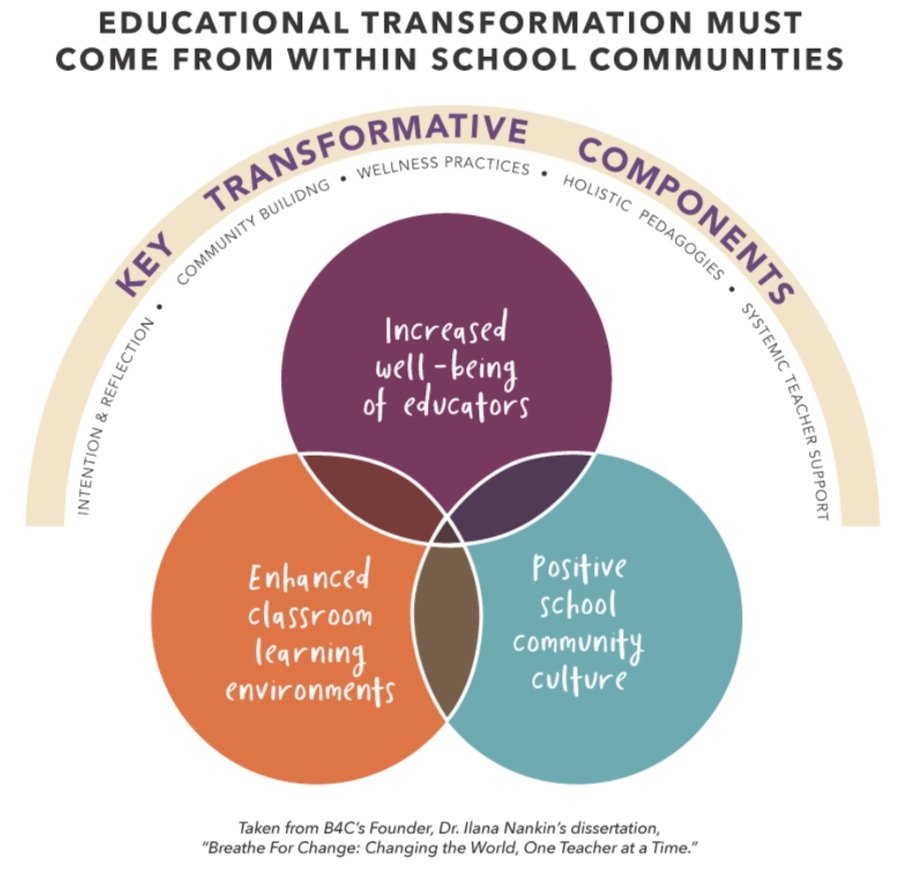Mindfulness in the Classroom
Mindfulness has an immeasurable positive impact on our well-being. How can we weave in mindfulness to best benefit our students?
By Sarah Nussdorfer

Mindfulness is a word that has gained popularity in recent years, and it can often seem like just one more thing to do. However, mindfulness practices support our students and their emotional regulation and benefit us, too. It can be used in all classrooms, regardless of subject or age group. Mindfulness improves focus and concentration, supports emotional regulation, and supports healthy, growth mindsets.
Through my training at Breathe for Change, I learned many techniques I have implemented in my kindergarten classroom, in my Community Education yoga and mindfulness courses, and with multi-age groups I see after school. The rewards have been immeasurable.
Parents have reported how students use our techniques at home, and I see students using our breathing exercises to regulate their emotions independently by the end of the year. In addition, when students do become dysregulated in our classroom, which happens, they can ask for help in the way they need it clearly.
3 Strategies to Promote Mindfulness in the Classroom
Strategy 1: Chime Time
One of my “go-to” techniques is *Chime Time*. I use this simple, yet highly-effective strategy to get students focused on learning and in transitions. It grounds us all and supports our full engagement with the present moment in class.
For the strategy, you would need a chime or bell.
- Invite students to sit or stand; their eyes may be open or closed.
- Ring the bell or chime
- Have the students sit very quietly until the sound can no longer be heard.
- When students believe the sound is done, they’ve been instructed to make a hand signal (be sure to review school-appropriate hand signals), such as a peace sign.
I repeat 2-3 times and invite students to ring the chime. Students love ringing the chime, and it becomes one of the best ways to get their attention and bring down their energy level.
Strategy 2: Creative Expression
Creative expression is a critical component in the Breathe for Change SEL*F Components, and supports students in expressing themselves differently. I use this as a stress reducer and as a calming technique during our quiet time in my class. It supports self expression and creates ways to connect as a community. It is also a big stress reducer before assessments and big projects.

2nd grade student’s first draft of her outdoor scene
In my classroom, we set both personal and collective class goals. When we plan our goals, the students get to choose our reward if we meet the objectives. For example, one of our early goals is to know all of our letters and their sounds. As we set this goal, we also will set a reward for when we meet our goal. When choosing a reward, I have found many students enjoy doing art, painting, and crafts. I allow for creative expression and individualism, and students can make their creations their own. Many students will create paintings using their hands to make an alligator or a jellyfish. Others may want to create beaded friendship bracelets to share with others in the class or school. When it comes to creative expression, it is best to have lots of options!
During this time, I weave in choices for different expressions—-such as creating using paints, play dough, painting with q tips or sponges, an creating with construction paper, scissors, markers, and glue. Or perhaps students may want to create a poem or song to express themselves. Students get to show their creativity and their passions. We also discuss how students can use this type of expression at home or when they may feel stressed or need a break. I teach students art expression with everyday objects (like Q-tips.) Using everyday objects make the expression more accessible for all families.
Throughout the creation process, we will have 2-3 times of painting, drawing, or creating, so that students can add more depth to the paintings and ensure it is portraying the message or beauty that the student wants. Having these “draft sessions” is crucial because just as we edit writing before publishing it, creating art also requires us to go back in and edit to ensure it expresses what the student is trying to convey.
Students will be given a theme such as an outdoor scene or under the sea if they struggle to decide how they want to create or express that day. Some students need a jumping off point, while others have ideas for days on what and how they want to make. I respect and encourage all types of expression as long as it communicates something important to the student.
Strategy 3: Flower Breath
Another everyday technique that has become valuable in our class is the Flower Breath from Breathe for Change. I use the Flower Breath during transition times to help slow everyone down and get us focused on a new activity, such as reading or math whole group instruction. It is very helpful and focuses us on learning. The Flower Breath is also a game changer during times when students are significantly dysregulated and need to calm down their nervous system. My students will even do this when they are upset on their own once we learn it enough for it to become natural for them.
To do a Flower Breath:
- Students put their hands together with their pinkies and thumbs touching, closed like a flower.
- As they breathe in, they lift their flowers and open their fingers while keeping their pinkies and thumbs touching.
- As students breath out, they will close their flowers again in front of their hearts.
- You will continue this breathing with opening flowers up on inhale and closing flowers down on exhale.
- Repeat as many times as you would like. (I do 3-5).
We repeat this breathing technique often; once students learn it, it is one of their favorites.

Above: Flower Breath from Breathe for Change


Sarah Nussdorfer
Sarah Nussdorfer is a yogi, educator, and literacy expert who teaches Kindergarten in Dearborn, Michigan. Sarah is interested in Educational Leadership and has led the Mindfulness Club program at her school. She teaches community yoga classes for adults and children. Sarah has received her 200 hr yoga teacher and SEL*F (Social Emotional Facilitator) training from the Breathe for Change program and has a Master of Arts in Educational Leadership from Saint Leo University.
As a survivor, Sarah’s passions include bringing breathwork, mindfulness, and meditation to students and teachers to support trauma healing and trauma-informed practices. Sarah believes that every student matters and should believe in his/her/their uniqueness and worth. Sarah helps students develop strong, positive self-images rooted in confidence and staying grounded.
Sarah is also the founder of Live, Love, Learn—a Mindful Education Consulting company. Her mission is to support all education stakeholders, especially the students and teachers, one breath at a time.


Excellent article, Sarah. Lots of helpful suggestions. Keep up the good work. So proud of you.